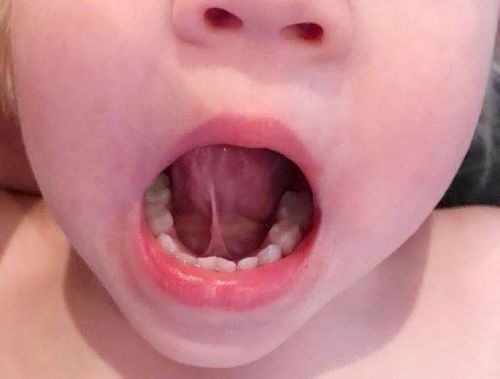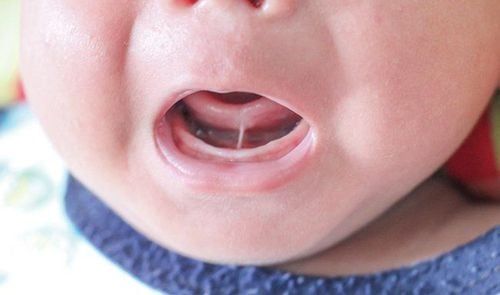This is an automatically translated article.
Tongue adhesion or short tongue brake is a birth defect in the tongue of a child. This is a mild deformity and can be treated with a tongue brake surgery.1. What is a tongue brake?
Adhesion of tongue brake, also known as tongue brake, short tongue brake, low tongue brake is a congenital anomaly of the tongue structure, when the tongue brake (a thin, triangular-shaped mucous membrane adheres between the floor of the mouth and the lower surface of the mouth). of the tongue) is short, the structure is thick and taut, adherent near the tip of the tongue.There are 4 types of tongue adhesions that are:
Tongue adhesion: Tongue adhesion is the most common type of tongue brake, children have a thin film near the tip of the tongue, sticking to the front of the tongue. Middle adhesions : Sticks the middle part on the underside of the tongue. Adhesion farther to the middle : Attaches the middle part on the underside of the tongue but farther. Floor adhesions: Oral floor adhesions are the rarest types of tongue adhesions, the floor of the child's mouth is attached to the back on the underside of the tongue, the tip of the tongue is not attached and the tongue is very thick. There are 3 degrees of adhesion of the tongue brake (applicable to all 4 types mentioned above):
Grade I : The tongue works normally, can be extended forward and to the sides, the tip of the tongue can touch the hard palate. Grade II: The tongue is limited in activity, the tip of the tongue cannot touch the hard palate. Grade III: The tongue cannot move forward, on both sides, the tip of the tongue cannot be brought up to touch the palate because the tip of the tongue is attached to the floor of the mouth. The type and extent of lingual adhesions was determined by lifting the lingual brake wire upward and examining the shape, and assessing the thickness and adhesion of the larynx when the infant cried.

Dính thắng lưỡi là một dị tật bẩm sinh về cấu trúc lưỡi
2. Signs to identify a child with a tongue brake
Children with tongue entrapment have the following signs:
Children have difficulty moving their tongue, especially when moving to the sides, up or sticking out their tongue because the tongue is short. The tip of the tongue forms a square instead of pointed as usual. Or the tip of the tongue is heart-shaped because the tongue is limited to moving forward or backward (this happens when the baby cries). In infants, the baby sucks for a longer time or makes a sound when feeding. Older children have tilted lower teeth or between the 2 lower incisors with gaps. Children with tongue-tie may be slow to speak because their tongue is restricted in movement, making pronunciation more difficult.
3. When can the baby tongue brake be cut?
Depending on the type and extent of the tongue adhesions, the child will be asked to have the procedure done early or wait until the right time. However, tongue scraping should be done as soon as possible to avoid affecting the child's eating and speech.
If the child is found to have a tongue tie right after birth and has the membrane, the tip of the tongue, the child may be cut off the tongue stick immediately because the procedure is simple, the child does not need to use medicine. numbness, little pain and almost no bleeding when cut.
After cutting the tongue for about 10-15 minutes, the baby can feed normally again. Cutting the tongue stick at this time is completely unaffected to the child's psyche. If left for a long time, it can cause pain when cutting and bleeding a lot because the baby is older, the blood vessels and nerves in the tongue brake develop more.
For the remaining 3 types of tongue brake, it is necessary to wait until the child is older than 2 years old to perform the tongue brake surgery because at this time the child needs to be anesthetized. In case the child has a blood clotting disorder or has an infection in the mouth, it is not recommended to perform the tongue-stick surgery.
4. Things to note after cutting the tongue brake for your baby
Cutting the tongue brake is a simple procedure and does not pose any danger to the child. Children after cutting the tongue brake can eat normally and rarely have pain. In some cases, a little white pseudomembranous may appear at the cutting site, but it is not infectious and does not cause pain or discomfort to the child, and the pseudomembrane will gradually fall off. Therefore, parents do not need to worry too much about this situation.After cutting the tongue brake for the baby, parents should note:
Do not let the child touch the tongue brake with their hands because it can cause infection if the child's hands are dirty. Do not allow children to bite or put hard objects in their mouths to avoid bleeding. Give your child the right dose and at the right time as directed by the doctor. After cutting, give the child cold, liquid food, drink milk and drink plenty of water. Do not give your child hot foods for the first day after the procedure. Instruct the child to do some tongue movement exercises as directed by the doctor so that the tongue can move better and avoid scarring after cutting the tongue brake. For young children, parents help children clean the lower part of the tongue, then guide the child to perform the movement of bringing the tongue up. For older children, immediately after cutting, instruct the child to stick out the tongue forward, bringing it up. Take the child for a follow-up visit if any abnormalities occur. Treatment of baby's tongue brake is a simple and non-hazardous procedure, so it should be done early so as not to affect the child's eating and pronunciation.

Sau khi cắt phanh lưỡi cho bé, hãy đưa trẻ đến tái khám nếu có bất thường xảy ra
Pediatrics Department at Vinmec is one of the few multi-specialty hospitals with a full range of doctors specializing in neurology, cardiology, gastroenterology, nutrition, psychology, endocrinology, hepatology, helping to handle it quickly and in a timely manner. when diseases are discovered during the examination. As a key area of Vinmec Medical system, Pediatrics Department always brings satisfaction to customers and is highly appreciated by industry experts with:
Gathering a team of leading pediatricians: including leading experts with high professional qualifications (professors, associate professors, doctorates, masters), experienced, worked at major hospitals such as Bach Mai, 108.. Doctors All are well-trained, professional, with a mind - range, understanding young psychology. In addition to domestic pediatric specialists, the Department of Pediatrics also has the participation of foreign experts (Japan, Singapore, Australia, USA) who are always pioneers in applying the latest and most effective treatment regimens. . Comprehensive services: In the field of Pediatrics, Vinmec provides a series of continuous medical examination and treatment services from Newborn to Pediatric and Vaccine,... according to international standards to help parents take care of their baby's health from birth to childhood. from birth to adulthood Specialized techniques: Vinmec has successfully deployed many specialized techniques to make the treatment of difficult diseases in Pediatrics more effective: neurosurgery - skull surgery, stem cell transplantation. blood in cancer treatment. Professional care: In addition to understanding children's psychology, Vinmec also pays special attention to the children's play space, helping them to have fun and get used to the hospital's environment, cooperate in treatment, improve the efficiency of medical treatment.
Please dial HOTLINE for more information or register for an appointment HERE. Download MyVinmec app to make appointments faster and to manage your bookings easily.













